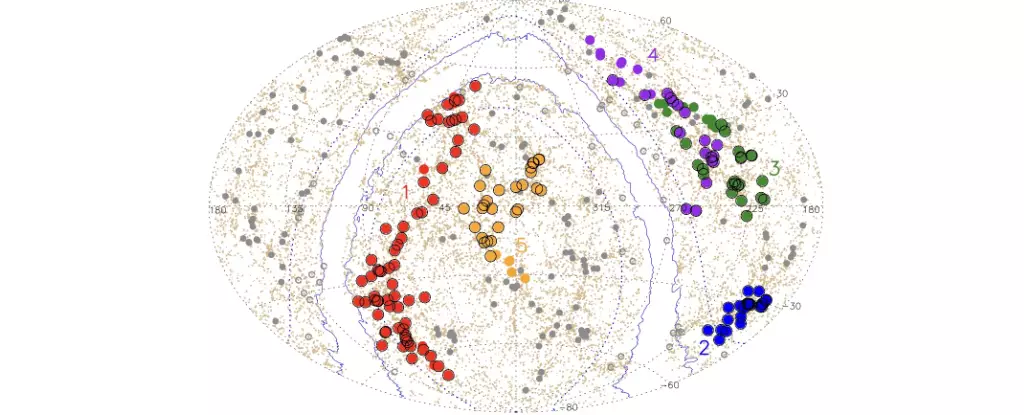Understanding the vastness of the Universe is an immense challenge, one that requires us to grapple with structures of unimaginable scale. The recent discovery of the Quipu superstructure, which harbors an astonishing mass equivalent to 200 quadrillion solar masses, underscores the necessity of examining these colossal entities. Perched at more than 400 megaparsecs in length—translating to over 1.3 billion light-years—Quipu exemplifies how astronomical phenomena can distort both measurements and interpretations of cosmic evolution. As we delve deeper into these grand structures, we begin to unravel the intricate tapestry of the cosmos and gain insights into its underlying mechanics.
The study titled “Unveiling the largest structures in the nearby Universe: Discovery of the Quipu superstructure,” led by Hans Bohringer and published in *Astronomy and Astrophysics*, elucidates the critical role large-scale structures play in cosmological models. The authors emphasize that to define cosmological parameters accurately, we must first comprehend the substantial influence that these vast formations exert on cosmic measurements. The distortions they introduce are not merely academic; they provoke real implications for our understanding of phenomena such as the Cosmic Microwave Background (CMB) radiation, gravitational lensing, and even the Hubble constant that delineates the Universe’s expansion rate.
Astrophysical theories have long grappled with quantifying the influence of gravity stemming from such behemoth structures. The gravitational pull of superstructures like Quipu modifies the CMB—relic radiation from the Big Bang—by creating fluctuations that obscure our theoretical predictions. This unprecedented interconnection between formation scale and measurement accuracy presents astronomers with the dual challenge of understanding these colossal entities while simultaneously recalibrating existing models that fail to account for such immense gravitational forces.
Superstructures are pivotal for understanding cosmic evolution due to their ability to influence the distribution and behavior of galaxies. They are not merely collections of galaxies but rather loci of gravity that play a fundamental role in the interactions and transformations of cosmic matter. Quipu and its companions contain significant portions of the total galaxy clusters, galaxies themselves, and matter distribution in the Universe, revealing their eminent status.
The study demonstrates that Quipu and four other identified superstructures collectively account for 45 percent of galaxy clusters, indicating that models failing to consider such formations are incomplete at best. The distinction between field clusters and those situated within superstructures is profound, necessitating a more nuanced approach to surveying the Universe’s layout. These differences beg the question of how intergalactic forces shape the evolution of galaxies, hinting at complex dynamics operating across vast cosmic terrains.
One of the fascinating aspects of these superstructures is their role in gravitational lensing. The immense mass of superstructures distorts the light from galaxies and other celestial bodies, creating visual artifacts that can mislead researchers. Instead of merely being challenges, these quirks of cosmic architecture hold the potential for new discoveries. The nuances provided by gravitational lensing phenomena allow astronomers to understand mass distribution, revealing hidden components of the Universe.
This lensing effect emphasizes the integral connection between visual data and underlying mass structures. Gravitational lensing not only introduces complexities into our observational frameworks but also serves as a tool to investigate the physical properties of superstructures. In a way, these massive constructs can both obfuscate and clarify our understanding of cosmic history.
The astronomical community now stands at a precipice of discovery, with superstructures like Quipu providing crucial insights into the dynamics of the Universe. As we explore their gravitational interplay and effects on neighboring celestial bodies, we are encouraged to reconsider the very fabric of our cosmological models. Bohringer and his team’s observations also suggest that these structures are transient—evolving over cosmic timelines to possibly become fragmented as the Universe continues to expand.
Quipu represents not just a colossal structure within the cosmos but a lens through which we can re-evaluate our comprehension of the Universe at large. There are still many questions to clarify, particularly concerning the implications of these vast formations on galactic behavior and evolution. Future research may illuminate how these structures interact with their environments, forging new pathways of understanding, and ultimately deepening our appreciation of the cosmic order. As we parse through these complexities, it becomes increasingly evident that our journey to comprehend the Universe is paved with monumental structures that reshape our every consideration of cosmic existence.

